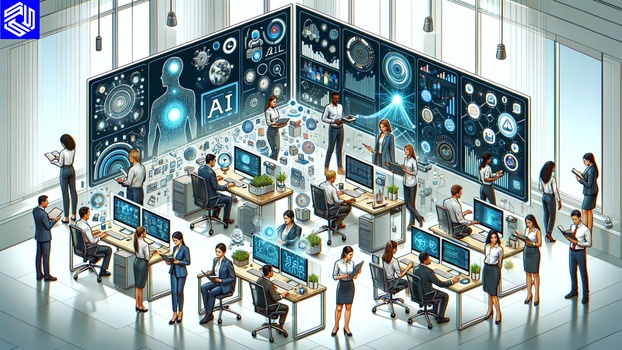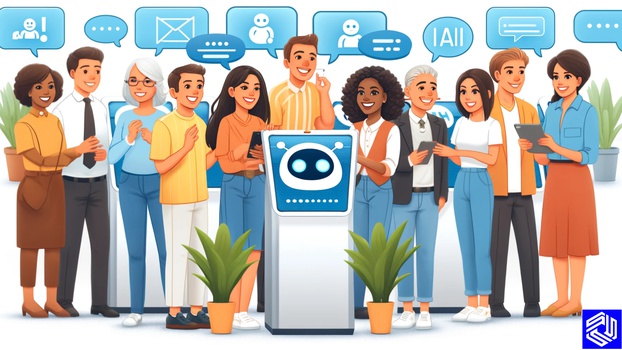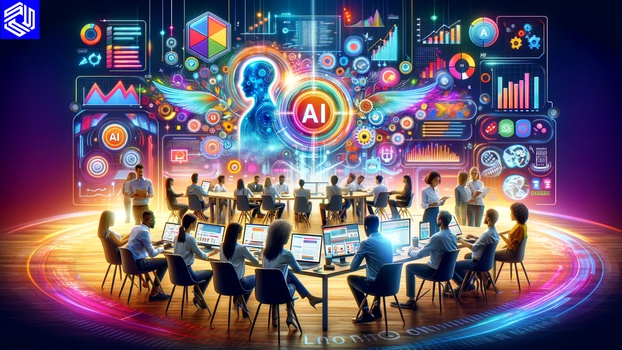Transforming Business with Generative AI: Practical Use-Cases of Generative AI in Business
Welcome to the future, where artificial intelligence isn’t just a buzzword—it’s a business revolution! Generative AI is stepping out of sci-fi and into the boardroom, transforming how we work, innovate, and interact with customers across the globe.
But what exactly is generative AI? Imagine a technology that can create, design, and solve problems almost like a human—only faster and sometimes even smarter. From crafting perfect marketing copy to designing stylish new products, generative AI is rapidly becoming an indispensable tool in the business toolkit.

In this blog, we’ll dive into the nuts and bolts of how generative AI is making waves across various sectors. We will focus on the following:
- Picking the Right Generative AI Applications for Your Business
- Practical Use-Cases of Generative AI in Business
- Get Started
Finding the Perfect Match: Picking the Right Generative AI Applications for Your Business
So, you're pumped about the possibilities of generative AI, but where do you start? Not all AI applications are created equal, and picking the wrong one is like bringing a skateboard to a car race—fun, but not going to win you any prizes. Whether you’re in marketing, customer service, product development, or e-commerce, there’s something in the AI magic box for everyone. It's all about finding the right fit for your business needs.

Why Pick Carefully? First things first, why be choosy? Because generative AI is a powerhouse that can turbocharge your business operations—if used wisely. Missteps can be costly, not just in dollars, but in time and resources. The key is to leverage AI where it can make the biggest splash in efficiency and innovation.
Criteria for Choosing Wisely:
- Assess Your Pain Points: Start by looking at areas where you’re spending too much time or money, or perhaps where errors are more frequent. These are your low-hanging fruits!
- Volume Matters: Generative AI thrives on tasks that are high in volume and repetitive in nature. Think generating monthly reports, answering common customer queries, or churning out those pesky administrative emails.
- Impact Potential: Consider areas where AI can not only improve processes but also create new opportunities. Can AI help you design a product that’s a total game-changer? What about personalizing user experiences to boost sales?
- Data Availability: AI needs data like plants need sunlight. Ensure you have access to clean, organized data to feed the AI beast, allowing it to learn and perform effectively.
By applying these criteria, you can pinpoint where generative AI will not just fit, but absolutely thrive in your business landscape. Remember, the goal is to make your life easier and your business more dynamic. So, think big, start smart, and let AI take your business operations from 'meh' to 'marvelous'!
Practical Use-Cases of Generative AI in Business
Imagine a realm where AI doesn't just streamline operations but transforms them, offering not just solutions but game-changing innovations. From automating customer interactions to designing cutting-edge products, the applications of generative AI are not just innovative but instrumental in giving businesses a substantial competitive edge.
Use-case 1: Customer Support with AI-Powered Chatbots

Ever wished you could clone your best customer service rep? Well, AI-powered chatbots are the next best thing! These digital dynamos are on the front lines, transforming customer service from sleepy to supercharged. Let’s dive into how these AI allies are making life easier for businesses and customers alike.
Why Chatbots? Imagine having a team that never sleeps, eats, or takes breaks, and is always in a good mood. That's what you get with AI chatbots. They handle queries round the clock, ensuring your customers get instant responses whether it's 3 PM or 3 AM. From simple questions like "What are your opening hours?" to more complex inquiries, chatbots can manage it all with flair.
McKinsey's research provides compelling evidence of the transformative impact of AI-powered chatbots on customer satisfaction and transaction value. Specifically, their findings reveal a notable 15% increase in customer satisfaction, indicating a marked improvement in the overall shopping experience. Additionally, the data shows a substantial 12% rise in average transaction value, demonstrating the chatbot's ability to drive revenue growth by enhancing customer engagement and conversion rates.
The Takeaway Chatbots are more than just conversation starters—they're your 24/7 customer service superheroes. By handling routine inquiries, they free up your human staff for more nuanced interactions, enhancing overall customer service. Whether you’re selling socks or software, integrating a chatbot can lead to happier customers and a healthier bottom line.
Use-case 2: Content Marketing with Generative AI

Generative AI is a tool that can really help with making content like blog posts or social media updates. It's like having an assistant who is always ready to help you write.
How AI Helps Create Content: AI can write drafts for you, come up with new ideas, or even make sure your writing style matches what your readers like. This can be really useful when you need to create a lot of content regularly.
Benefits of Using AI for Content:
- Consistency: AI helps keep your writing style the same across all your posts and articles. This is good because it helps your readers know what to expect from your brand.
- Keeping Up with Trends: AI can look at lots of data from the internet to figure out what topics are becoming popular. This means you can write about things that more people want to read about.
- Saving Time: With AI, you can produce more content faster. This is great when you need to keep your website or social media fresh and interesting without spending too much time writing.
Using AI can make your content marketing much easier and more effective. It's like having a smart tool that helps you write better and faster, keeping your audience engaged. GenAI is really about unleashing potential, speeding up processes, and delivering groundbreaking results. If you're in the design industry and not thinking about how AI can be integrated into your work, now's the time to start.
Use-case 3: Innovating Product Design and Development with AI

Generative AI is a tool that helps create new designs in areas like fashion, architecture, and making products. It's like having a very smart assistant that can come up with lots of new ideas quickly.
How AI Helps with Design:
Generative AI is a powerful tool that is changing how things are designed in industries like fashion, architecture, and product development. In these fields, AI can help create many different designs quickly, which allows designers to explore more ideas and find the best ones faster. For example, in fashion, AI can come up with new clothing designs by combining different colors, shapes, and materials that might take humans much longer to think of.
AI also speeds up the process of making prototypes, which are early models of products used to test ideas. This is especially helpful in industries like architecture, where AI can quickly generate models of buildings. This allows architects to see what a building will look like and make changes more easily. By using AI, companies can save time and money, and bring new, innovative designs to the market faster. This makes businesses more efficient and helps them stand out from the competition.
Examples of AI in Design:
- Fashion: A clothing company can use AI to create new styles of dresses or shirts. The AI looks at the latest fashion trends and comes up with designs that people might like. This helps the company make new clothes faster.
- Architecture: Architects can use AI to design new buildings. The AI can suggest designs that not only look good but are also practical and good for the environment. This speeds up the process of making building plans.
- Product Design: A company that makes kitchen tools might use AI to come up with new gadget ideas. The AI can test different shapes and sizes to find the ones that are easiest to use. This helps the company create better products quicker.
Use-case 4: Enhancing Financial Analysis and Reporting through AI

AI tools are really helpful when it comes to managing money in businesses. They can handle complicated math and create detailed reports without much help from people. This makes understanding finances easier and quicker. Say goodbye to the days of daunting spreadsheets and endless number crunching! Think of AI as your very own financial wizard, working 24/7 to sort, sift, and make sense of mountains of financial data. With its ability to automate complex calculations and generate detailed reports, AI is a must have tool.
How AI Helps with Finances:
- Automating Calculations: AI can quickly do a lot of complex calculations that used to take people a long time to finish. This includes things like figuring out profits, costs, and financial health.
- Creating Reports: AI can put together detailed financial reports automatically. These reports help show how a business is doing and what might happen next with its money.
- Risk Assessment: With AI, businesses can better understand and mitigate financial risks by forecasting market changes and assessing potential impacts before they happen.
Impact on Business Strategy and Decision-Making:
Strategic Planning - AI-driven insights allow companies to make informed strategic decisions quickly, aligning financial goals with market opportunities.It also provides enhanced accuracy, reduced human error means more accurate forecasts and budgets, leading to better financial planning and resource allocation.Lastly, AI’s ability to provide real-time data analysis helps executives make pivotal decisions on the fly, keeping the business agile and ahead of the curve.
Success in the Field:
- The Retail Giant: A multinational retailer implemented AI for financial forecasting, resulting in a 20% increase in budget accuracy and timely resource adjustments that spiked their market competitiveness.
- The Startup Story: A fintech startup used AI to refine its investment strategies, achieving a 30% better return on investment through precise trend predictions and market analysis.
The financial world is ripe for AI integration. From boosting your bottom line to sharpening your strategic edge, AI in financial analysis isn’t just a smart choice—it’s a must-have for modern businesses looking to thrive in a data-driven market.
Use-case 5: Shop ‘Til You Drop. Personalizing E-Commerce with Generative AI

AI is changing the way we shop online by making it more personal. It can look at what you like to buy and how you shop, and then suggest products that you might like. This makes shopping easier and more fun for customers. Gone are the days of one-size-fits-all shopping experiences! Generative AI is changing the way we shop online, making every click and scroll a step towards a more tailored and delightful shopping journey. Let’s dive into how AI is turning every online store visit into a personalized shopping spree.
Tailor-Made Shopping Adventures AI doesn’t just understand trends; it understands your customers. By analyzing shopping behaviors, past purchases, and even browsing habits, AI crafts personalized recommendations that hit the mark every time. This isn't just convenience—it's about creating a connection, making your customers feel like your platform was made just for them.
Benefits of AI-Personalized Shopping:
- Understanding Customers: AI watches how customers shop, like what they look at and what they buy. Then, it uses this information to show them products they are likely to buy.
- Personal Recommendations: AI can suggest products that fit what you usually buy. For example, if you often buy children's books, AI might suggest the latest bestseller in that category.
- Enhanced User Experiences: From personalized homepages to tailored email marketing, AI makes every touchpoint a personalized interaction, enhancing the overall user experience.
Using Chatbots in E-commerce:

Using chatbots offers a myriad of benefits that extend well beyond simple customer interactions. These AI-powered assistants enhance the shopping experience by:
- Enhancing Customer Service Efficiency: AI chatbots excel in providing real-time assistance to customers, significantly reducing wait times that are typically associated with human support. By instantly responding to inquiries, whether about product details, shipment tracking, or return policies, chatbots streamline the support process, allowing for a more fluid shopping experience.
- Personalizing the Shopping Experience: Chatbots leverage the power of AI to offer personalized shopping advice based on customer preferences and previous interactions. For instance, if a customer frequently purchases sports gear, the chatbot can recommend the latest arrivals or exclusive deals in that category, effectively mirroring the helpful guidance of an in-store assistant.
- Scaling Customer Interactions: During peak times, such as holiday sales or special promotions, chatbots can handle thousands of interactions simultaneously, something that would require a massive human customer service team to manage. This capability ensures that every customer receives attention without the typical delays or backlogs, maintaining high service quality regardless of traffic spikes.
- Gathering Valuable Insights: Beyond customer service, chatbots are invaluable for gathering data on customer preferences and behaviors. By analyzing the questions and feedback received, businesses can identify common concerns, gauge product popularity, and understand customer needs better.
- Reducing Operational Costs: Implementing chatbots can lead to significant reductions in operational costs. By automating routine tasks and handling multiple customer inquiries at once, chatbots free up human agents to tackle more complex issues, thereby optimizing the workforce and reducing the need for a large customer service team.
Generative AI is not just changing how we shop; it's enhancing why we shop online in the first place. For e-commerce platforms, integrating AI means not just selling products, but creating a shopping experience that feels personal, thoughtful, and engaging. Ready to give your customers a shopping experience that’s all about them? AI is your go-to digital salesperson!
Let's Wrap it Up!
And there you have it! From chatbots that offer round-the-clock customer service to AI that designs everything from trendy tees to towering skyscrapers, the potential of generative AI is as vast as it is exciting. We’ve seen how AI can automate the mundane, inspire the creative, and personalize the impersonal, transforming how businesses operate across various sectors.
Your AI Journey Awaits So, what’s your AI story going to be? Every business has unique challenges and needs, and there’s almost certainly an AI solution that can make a significant impact. Now is the time to explore, experiment, and embrace the AI revolution. If you do not know where to start when adopting GenAI tools like chatbots, just visit KaraboAI and you will be amazed.









